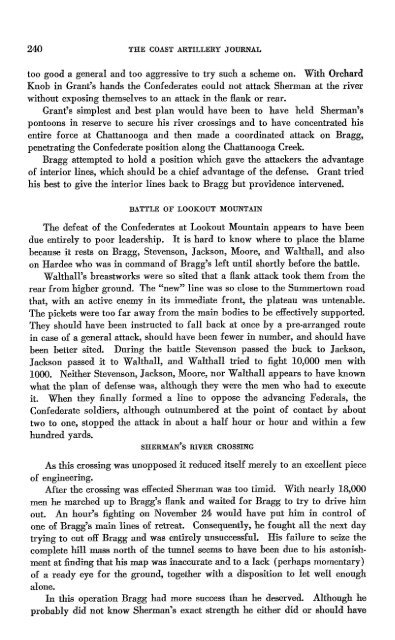THE COAST ARTILLERY JOURNAL - Air Defense Artillery
THE COAST ARTILLERY JOURNAL - Air Defense Artillery
THE COAST ARTILLERY JOURNAL - Air Defense Artillery
You also want an ePaper? Increase the reach of your titles
YUMPU automatically turns print PDFs into web optimized ePapers that Google loves.
240 <strong>THE</strong> <strong>COAST</strong> <strong>ARTILLERY</strong> <strong>JOURNAL</strong><br />
too good a general and too aggressive to try such a scheme on. With Orchard<br />
Knob in Grant's hands the Confederates could not attack Sherman at the river<br />
without exposing themselves to an attack in the flank or rear.<br />
Grant's simplest and best plan would have been to have held Sherman's<br />
pontoons in reserve to secure his river crossings and to have concentrated his<br />
entire force at Chattanooga and then made a coordinated attack on Bragg,<br />
penetrating the Confederate position along the Chattanooga Creek.<br />
Bragg attempted to hold a position which gave the attackers the advantage<br />
of interior lines, which should be a chief advantage of the defense. Grant tried<br />
his best to give the interior lines back to Bragg but providence intervened.<br />
BATTLE OF LOOKOUT MOUNTAIN<br />
The defeat of the Confederates at Lookout Mountain appears to have been<br />
due entirely to poor leadership. It is hard to know where to place the blame<br />
because it rests on Bragg, Stevenson, Jackson, Moore, and Walthall, and also<br />
on Hardee who was in command of Bragg's left until shortly before the battle.<br />
Walthall's breastworks were so sited that a flank attack took them from the<br />
rear from higher ground. The "new" line was so close to the Summertown road<br />
that, with an active enemy in its immediate front, the plateau was untenable.<br />
The pickets were too far away from the main bodies to be effectively supported.<br />
They should have been instructed to fall back at once by a pre-arranged route<br />
in case of a general attack, should have been fewer in number, and should have<br />
been better sited. During the battle Stevenson passed the buck to Jackson,<br />
Jackson passed it to Walthall, and Walthall tried to fight 10,000 men with<br />
1000. Neither Stevenson, Jackson, Moore, nor Walthall appears to have known<br />
what the plan of defense was, although they were the men who had to execute<br />
it. When they finally formed a line to oppose the advancing Federals, the<br />
Confederate soldiers, although outnumbered at the point of contact by about<br />
two to one, stopped the attack in about a half hour or hour and within a few<br />
hundred yards.<br />
SHERMAN'S RIVER CROSSING<br />
As this crossing was unopposed it reduced itself merely to an excellent piece<br />
of engineering.<br />
After the crossing was effected Sherman was too timid. With nearly 18,000<br />
men he marched up to Bragg's flank and waited for Bragg to try to drive him<br />
out. An hour's fighting on November 24 would have put him in control of<br />
one of Bragg's main lines of retreat. Consequently, he fought all the next day<br />
trying to cut off Bragg and was entirely unsuccessful. His failure to seize the<br />
complete hill mass north of the tunnel seems to have been due to his astonishment<br />
at finding that his map was inaccurate and to a lack (perhaps momentary)<br />
of a ready eye for the ground, together with a disposition to let well enough<br />
alone.<br />
In this operation Bragg had more success than he deserved. Although he<br />
probably did not know Sherman's exact strength he either did or should have
















